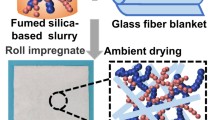Abstract
Organic–inorganic hybrid foams based on an alkali alumino-silicate matrix were prepared using different foaming methods. Firstly, silico-aluminate inorganic matrix, activated through a sodium silicate solution, was prepared at room temperature. The obtained viscous paste was expanded by means of silicon metal redox reaction in alkaline media in combination with protein-assisted foaming. The foamed systems were hardened at defined temperature and time and then characterized by FTIR, scanning electron microscopy, and compression tests. The high temperature behavior and specific surface area were also evaluated. The experimental findings highlighted that the combination of silicon metal and vegetable protein allowed tailoring hybrid foams with enhanced properties: good yield strength and thermal resistance typical of geopolymeric foam with a ductile behavior (toughness) and low density typical of organic foams.






Similar content being viewed by others
References
Landi E, Medri V, Papa E, Dedecek J, Klein P, Benito P, Vaccari A (2013) Alkali-bonded ceramics with hierarchical tailored porosity. Appl Clay Sci 73:56–64
Kamseu E, Nait-Ali B, Bignozzi MC, Leonelli C, Rossignol S, Smith DS (2012) Bulk composition and microstructure dependence of effective thermal conductivity of porous inorganic polymer cements. J Eur Ceram Soc 32(8):1593–1603
Duxson P, Fernández-Jiménez A, Provis JL, Lukey GC, Palomo A, van Deventer JSJ (2007) Geopolymer technology: the current state of the art. J Mater Sci 42(9):2917–2933. doi:10.1007/s10853-006-0637-z
Van Bonin W, Nehen U, Von Gizycki U (1975) Hydrogen peroxides blowing agent for silicate foams. US Patent 3,864,137
Vaou V, Panias D (2010) Thermal insulating foamy geopolymers from perlite. Miner Eng 23:1146–1151
Prud’Homme E, Michaud P, Joussein E, Peyratout C, Smith A, Rossignol S (2011) In situ inorganic foams prepared from various clays at low temperature. Appl Clay Sci 51(1):15–22
Studart AR, Gonzenbach UT, Tervoort E, Gauckler LJ (2006) Processing routes to macroporous ceramics: a review. J Am Ceram Soc 89(6):1771–1789
Colombo P, Vakifahmetoglu C, Costacurta S (2010) Fabrication of ceramic with hierarchical porosity. J Mater Sci 45:5424–5455. doi:10.1007/s10853-010-4708-9
Scheffler M, Colombo P (2005) Cellular ceramics: structure, manufacturing, properties and applications. Wiley–VCH Verlag GmbH, Weinheim, Germany
Lyckfeldt O, Brandt J, Lesca S (2000) Protein forming—a novel shaping technique for ceramics. J Eur Ceram Soc 20(14):2551–2559
Garrn I, Reetz C, Brandes N, Kroh LW, Schubert H (2004) Clot-forming: the use of proteins as binders for producing ceramic foams. J Eur Ceram Soc 24(3):579–587
Murray BS, Ettelaie R (2004) Foam stability: proteins and nanoparticles. Curr Opin Colloid In 9(5):314–320
Bos MA, Van Vliet T (2001) Interfacial rheological properties of adsorbed protein layers and surfactants: a review. Adv Colloid Interfac 91(3):437–471
Damodaran S (2005) Protein stabilization of emulsions and foams. J Food Sci 70(3):54–66
Chen J, Dickinson E (1998) Viscoelastic properties of protein-stabilized emulsions: effect of protein-surfactant interactions. J Agr Food Chem 46(1):91–97
Verdolotti L, Di Maio E, Forte G, Lavorgna M, Iannace S (2010) Hydration-induced reinforcement of polyurethane–cement foams: solvent resistance and mechanical properties. J Mater Sci 45(12):3388–3391. doi:10.1007/s10853-010-4416-5
Xu H, Van Deventer JSJ (2000) The geopolymerisation of alumino-silicate minerals. Int J Miner Process 59(3):247–266
Wang L, Tomura S, Suzuki M, Ohashi F, Inukai K, Maeda M (2001) Synthesis of mesoporous silica material with sodium hexafluorosilicate as silicon source under ultra-low surfactant concentration. J Mater Sci Lett 20:277–280
Zhang XG (2001) Elettrochemistry of silicon and its oxides. Kluver Academic/Plenum Publisher, New York
Mo BH, Zhu H, Cui XM, He Y, Gong SY (2014) Effect of curing temperature on geopolymerization of metakaolin-based geopolymers. Appl Clay Sci 99:144–148
Xu H, van Deventer JS (2003) The effect of alkali metals on the formation of geopolymeric gels from alkali-feldspars. Colloid Surface A 216(1):27–44
Komnitsas K, Zaharaki D (2007) Geopolymerisation: a review and prospects for the minerals industry. Miner Eng 20(14):1261–1277
Davidovits J (1991) Geopolymers. J Therm Anal Calorim 37(8):1633–1656
Medri V, Papa E, Dedecek J, Jirglova H, Benito P, Vaccari A, Landi E (2013) Effect of metallic Si addition on polymerization degree of in situ foamed alkali-aluminosilicates. Ceram Int 39(7):7657–7668
Gibson LJ, Ashby MF (1999) Cellular solids: structure and properties. Cambridge University Press, Cambridge, MA
Colombo P, Hellmann JR, Shelleman DL (2001) Mechanical properties of silicon oxycarbide ceramic foams. J Am Ceram Soc 84(10):2245–2251
Hung TC, Huang JS, Wang YW, Fan YC (2013) Microstructure and properties of metakaolin-based inorganic polymer foams. J Mater Sci 48(21):7446–7455. doi:10.1007/s10853-013-7559-3
Sing KSW, Everett DH, Haul RAW, Moscou L, Pierotti RA, Rouquerol J (1985) Pure Appl Chem 57:603–619
Acknowledgements
This work was supported by the Italian Ministero dell’Istruzione, dell’Università e della Ricerca (MIUR), and Ministero dello Sviluppo Economico within the framework of PON-2007-2013 under Grant PON02_000293206086 “COCET”. The authors gratefully acknowledge Dott. Manlio Colella for helping in analyzing SEM microscopy data.
Author information
Authors and Affiliations
Corresponding author
Rights and permissions
About this article
Cite this article
Verdolotti, L., Liguori, B., Capasso, I. et al. Synergistic effect of vegetable protein and silicon addition on geopolymeric foams properties. J Mater Sci 50, 2459–2466 (2015). https://doi.org/10.1007/s10853-014-8801-3
Received:
Accepted:
Published:
Issue Date:
DOI: https://doi.org/10.1007/s10853-014-8801-3




